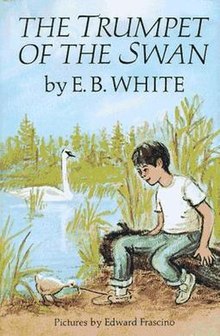 The Trumpet of the Swan
The Trumpet of the SwanE.B. White
HarperCollins, 1970 210 pages
Grades 3-6
Animal Fantasy
A young boy named Sam is camping with his father in the Canadian
wilderness. It is here that he observes two rare trumpeter swans build a nest
and hatch cygnets. Louis, one of the new hatchlings, is as healthy as his
siblings, only he cannot make any noise. It is imperative for trumpeter
swans to make noise especially for attracting a mate and warding off
enemies. Louis' father is concerned for his offspring and steals a trumpet from
a music store in hopes that his son can make sounds artificially. Meanwhile,
Louis finds other ways to communicate. He tracks down his old friend Sam and
attends school with him, learning to read and write. Armed with a
chalkboard around his neck and his newly acquired trumpet, Louis heads off
with Sam to play his trumpet at a remote summer camp. After camp Louis takes
his musical skills to Boston, where he plays by the swan boats, hoping to earn
enough money to pay off his father's debt from stealing the trumpet.
Louis' skills grow, as does his fame. Will he make good on his father's debt?
Will he ever find a mate? And what will become of Sam once he grows up? These
questions and more are answered in E.B. White's third and final
children's book.
E.B. White, of Charlotte's Web Fame, thought of himself as more of an adult writer, having spent his career working for The New Yorker Magazine. Yet his legacy as a writer for children is for what he is best remembered. The least known of his three works for children, The Trumpet of the Swan, is an excellent contribution to the cannon and still holds up over time. Animal lovers are the obvious audience, but enough happens in the plot to keep all readers interested. I love how E.B. White always includes a child who befriends his animal protagonists, thus offering a character for which young people can relate. Louis overcomes adversity with aplomb and cheerfulness. He is not afraid of hard work, traveling to new terrains, or jumping into new situations. Sam is also a character to emulate. He is a true and loyal friend whose kindness, patience, and quiet nature make him a natural with animals. Parts of the book are dated, but not to the point of distracting from the overall story. Certain stereotypical references are made to American Indians, as in walking quietly or being wild. The original cover (as seen above) does not do the book any favors, but more updated covers exist in newer editions and the black and white illustrations inside are sweet and less dated. An American classic worth a second look.
No comments:
Post a Comment